Stock Markets Oversold, Bottom Imminent
Stock-Markets / US Stock Markets Jan 13, 2008 - 08:28 AM GMTBy: Mike_Burk
The good news is: The market is likely to be at or near a short term bottom.
Short Term
My daily history of the S&P mid cap index (MID) begins in 1991. Including the period that ended last Tuesday there have been 3 occasions when the index has fallen for 9 consecutive days. The others were the period before and after 9/11/2001 and late August 1998. 9/11/2001 is obviously a special case, but there are numerous similarities between August 1998 and the current period including a threat to the financial system by the failure of Long Term Capital Management which, like Citibank, Merrill Lynch and Countrywide, was considered too big to fail.
In 1998 the small and mid cap indices peaked in April, hit a low in June, rallied to mid July when the blue chip indices hit their highs, declined into late August, rallied into late September then fell to their final cycle lows in early October.
The recent pattern has been similar. Most of the major indices hit highs in mid July, lows in mid August, rallied into mid October (where the blue chip indices made their tops while the mid and small cap indices did not) then fell to the recent lows.
The recent pattern has played out over about 6 months while the 1998 decline took about 41/2 months from the April highs to the August lows. The magnitude of the 1998 decline was nearly double what we have seen so far.
The first chart covers the past 6 months showing the MID in red and an indicator showing the percentage of the previous 9 trading days that were up in black. Dashed vertical lines have been drawn on the 1 st trading day of each month. The indicator would hit the top of the chart when there have been 9 consecutive up days and it hits the bottom of the chart when there have been 9 consecutive down days.
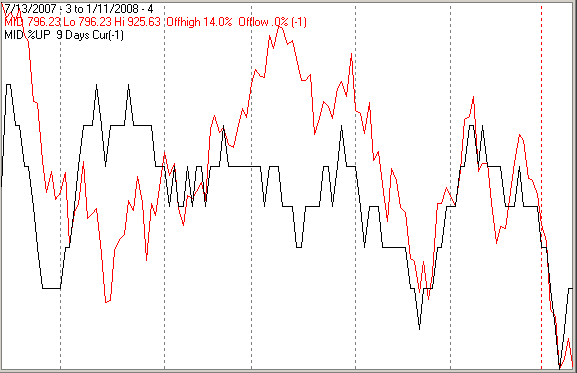
The next chart is similar to the one above except it covers the period from the April 1998 highs to the bottom in October. After 9 consecutive down days the index rallied for about 3 weeks before falling to its final low in October.
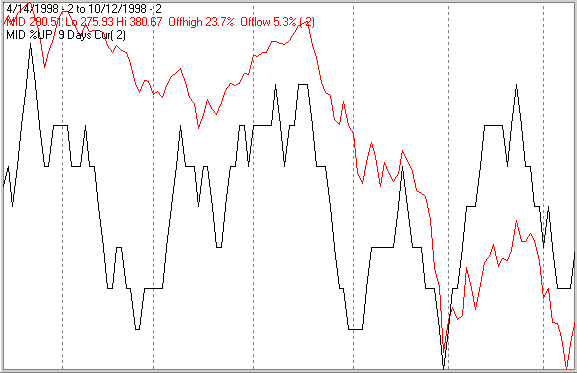
The MID was the only major index to decline for 9 consecutive days. I selected it because it was easier to make the point that we have recently seen an oversold extreme.
Intermediate Term
When the market hits a low with an extreme number of new lows it usually retests that low. Near the August low there were 480 new lows on the NASDAQ implying a retest of that low. Near the late November low there were 359 new lows, less than the August low, but still enough to suggest another retest. Last Wednesday there were 595 new lows on the NASDAQ suggesting another retest to come.
The chart below covers the past year showing the NASDAQ composite (OTC) in blue and a 10% trend (19 day EMA) of NASDAQ new lows (OTC NL) in red. OTC NL has been plotted on an inverted Y axis so decreasing new lows move the indicator upward (up is good). OTC NL is at its lowest point since the 2002 bottom.
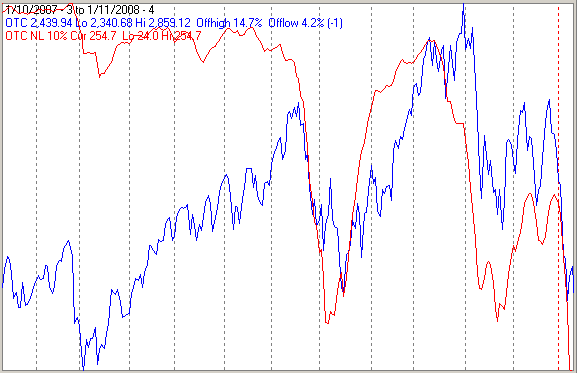
The next chart is similar to the one above except it shows the 1998 bottom. The OTC retested the August low in October with a lower low while OTC NL made a higher low not confirming the October price low.
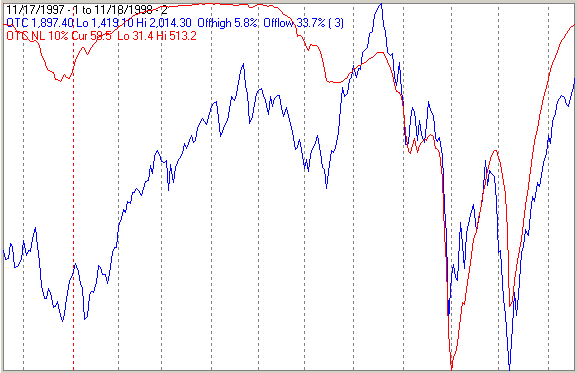
The OTC hit a new low for the cycle on Friday as did OTC NL, however, there were less than half the number of new lows on the NASDAQ on Friday than there were on Wednesday. The comparison was even better on the NYSE.
Money supply (M2)
The money supply chart has been provided by Gordon Harms.
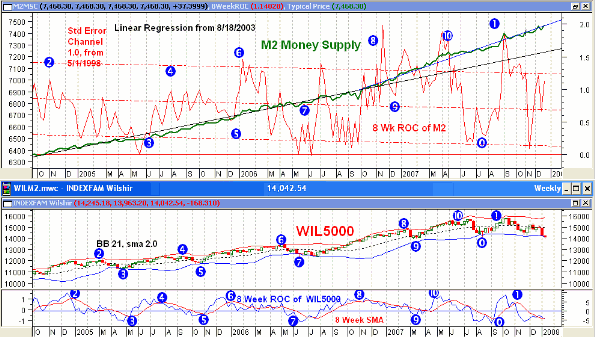
Seasonality
Next week is the week prior to the 3 rd Friday in January during the 4 th year of the Presidential Cycle.
The tables show the daily change of the OTC and SPX during the week prior to the 3 rd Friday in January during the 4 th year of the Presidential Cycle. OTC data covers the period from 1964 – 2004 and SPX data from 1953 – 2004. There are summaries for both the 4 th year of the Presidential Cycle and all years combined. Prior to 1953 the market traded 6 days a week so that data has been ignored.
Historically the SPX has been up about half of the time with modest gains over all years and modest losses during the 4 th year of the Presidential Cycle. The OTC however, has been quite strong, up 82% of the time during the 4 th year of the Presidential Cycle with an average again over 1%.
Report for the week before the 3rd Friday of January. The number following the year is the position in the presidential cycle. Daily returns from Monday through 3rd Friday.
| OTC Presidential Year 4 | ||||||
| Year | Mon | Tue | Wed | Thur | Fri | Totals |
| 1964-4 | -0.19% | 0.14% | 0.38% | 0.14% | -0.22% | 0.25% |
| 1968-4 | 0.43% | 0.18% | -0.85% | 0.36% | 0.16% | 0.28% |
| 1972-4 | 0.16% | 0.62% | -0.18% | -0.11% | -0.09% | 0.40% |
| 1976-4 | 0.49% | -1.56% | 2.70% | 0.13% | 0.68% | 2.44% |
| 1980-4 | 0.34% | 0.36% | 0.66% | -0.12% | 0.21% | 1.47% |
| 1984-4 | -0.20% | 0.20% | 0.12% | -0.25% | -0.73% | -0.85% |
| Avg | 0.25% | -0.04% | 0.49% | 0.00% | 0.05% | 0.75% |
| 1988-4 | 0.11% | -0.05% | -1.96% | 0.17% | 1.00% | -0.73% |
| 1992-4 | 0.31% | 1.31% | 0.81% | -0.55% | -0.08% | 1.81% |
| 1996-4 | -1.95% | 0.74% | 0.24% | 0.89% | 1.12% | 1.05% |
| 2000-4 | 0.00% | 1.64% | 0.50% | 0.92% | 1.10% | 4.15% |
| 2004-4 | 1.19% | -0.73% | 0.70% | -0.10% | 1.49% | 2.56% |
| Avg | -0.08% | 0.58% | 0.06% | 0.27% | 0.93% | 1.77% |
| OTC summary for Presidential Year 4 1964 - 2004 | ||||||
| Avg | 0.07% | 0.26% | 0.28% | 0.13% | 0.42% | 1.17% |
| Win% | 70% | 73% | 73% | 55% | 64% | 82% |
| OTC summary for all years 1963 - 2007 | ||||||
| Avg | 0.05% | 0.25% | 0.16% | 0.31% | 0.04% | 0.81% |
| Win% | 63% | 60% | 62% | 69% | 62% | 73% |
| SPX Presidential Year 4 | ||||||
| Year | Mon | Tue | Wed | Thur | Fri | Totals |
| 1956-4 | -1.19% | 0.75% | -0.67% | -1.02% | -1.14% | -3.28% |
| 1960-4 | -0.84% | -1.07% | -0.35% | 0.25% | 0.30% | -1.72% |
| 1964-4 | -0.03% | 0.18% | 0.37% | -0.12% | 0.01% | 0.42% |
| 1968-4 | -0.31% | -0.62% | -0.19% | -0.08% | -0.33% | -1.54% |
| 1972-4 | 0.30% | 0.34% | -0.16% | 0.00% | -0.22% | 0.25% |
| 1976-4 | 1.45% | -0.79% | 1.63% | -0.54% | 0.40% | 2.17% |
| 1980-4 | 0.42% | 0.69% | -0.08% | -0.32% | 0.33% | 1.05% |
| 1984-4 | 0.10% | 0.39% | -0.17% | -0.30% | -0.50% | -0.48% |
| Avg | 0.39% | 0.00% | 0.21% | -0.31% | -0.06% | 0.29% |
| 1988-4 | -0.07% | -1.02% | -2.68% | 0.21% | 1.38% | -2.17% |
| 1992-4 | -0.18% | 1.47% | 0.08% | -0.61% | 0.16% | 0.91% |
| 1996-4 | -0.33% | 1.44% | -0.34% | 0.31% | 0.59% | 1.66% |
| 2000-4 | 0.00% | -0.69% | 0.05% | -0.71% | -0.29% | -1.63% |
| 2004-4 | 0.48% | -0.53% | 0.83% | 0.14% | 0.69% | 1.60% |
| Avg | -0.03% | 0.13% | -0.41% | -0.13% | 0.50% | 0.07% |
| SPX summary for Presidential Year 4 1956 - 2004 | ||||||
| Avg | -0.02% | 0.04% | -0.13% | -0.23% | 0.11% | -0.21% |
| Win% | 42% | 54% | 38% | 33% | 62% | 54% |
| SPX summary for all years 1953 - 2007 | ||||||
| Avg | -0.03% | 0.13% | 0.03% | 0.13% | -0.09% | 0.17% |
| Win% | 46% | 58% | 56% | 61% | 53% | 53% |
Conclusion
The market is very oversold and likely to be at or near a short term bottom.
I expect the major indices to be higher on Friday January 18 than they were on Friday January 11.
Last weeks positive forecast based on a rally from an oversold condition was a miss.
By Mike Burk
To subscribe to this report : http://alphaim.net/signup.html
Gordon Harms produces a Power Point for our local timing group. You can get a copy of that at: http://www.stockmarket-ta.com/ .
Disclaimer: Mike Burk is an employee and principal of Alpha Investment Management (Alpha) a registered investment advisor. Charts and figures presented herein are believed to be reliable but we cannot attest to their accuracy. Recent (last 10-15 yrs.) data has been supplied by CSI (csidata.com), FastTrack (fasttrack.net), Quotes Plus (qp2.com) and the Wall Street Journal (wsj.com). Historical data is from Barron's and ISI price books. The views expressed are provided for information purposes only and should not be construed in any way as investment advice. Furthermore, the opinions expressed may change without notice.
Mike Burk Archive |
© 2005-2022 http://www.MarketOracle.co.uk - The Market Oracle is a FREE Daily Financial Markets Analysis & Forecasting online publication.



